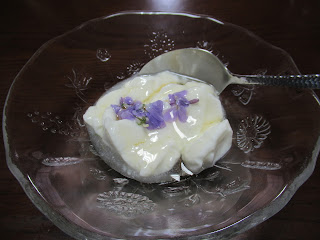Probably the most charming spring ephemeral in Yokohama is violets. They show off their small and lovely leaves and flowers wherever they find they can sprout. In Yokohama, people find Viola grypoceras in March and realize spring has come. Their petite cuteness can fool and let us imagine them coming from enchanting world of fairies. Buuuut, when they end their flowering time and bear fruits for procreation, they grow up to 20cm or more in height with very large leaves. In summer, they lose their prettiness and turn into uber vigorous undergrowth. In fall, their above ground parts wither but they are alive as underground rhizome to overwinter. Next spring, they become spring fairies again. It’s a well-thought-out plan. Do not underestimate their natural power, yeah.
 |
| Viola grypoceras |
Violets bear “dehiscent” fruits so that their seeds will be ejected from pods when time comes. In addition, they have another clever strategy to disperse their offspring. They are one of the most famous plants whose seeds have elaiosome. The stuff attaches to their seed. It is rich in lipids and proteins. Ants and the other bugs find them very nutritious and collect elaiosome together with seed. They eat the elaiosome and throw away the seed. That’s the reason why we often find violets right next to an ant hole. And so, when a nest of ants has their entrance on a stone wall, or in the fissure of asphalt of commuter road, violets poke their flowers there.
 |
| Viola mandshurica |
 |
| Viola phalacrocarpa |
 |
| Viola keiskei |
Then, there exists a strange pattern for me. Viola grypoceras are so ubiquitous. In Yokohama, omnipresent Viola grypoceras spread their colony in comfortable forest floors or lawns in parks. In contrast, those less common violet species are often situated in shoulders of paved roads. Although sometimes we can find their parents in a nearby garden, their kids find themselves literally stuck between a rock and a hard place of busy car road. We even encounter them at the feet of a pole for bus stop. Why? Why don’t they flower in nearby forest as Viola grypoceras? They might be brought by humans, not by ants … happen to find a fissure in car road to sprout? They could simply be unlucky … But why can Viola grypoceras dominate easy neighborhood, while those others put up with the urban jungle? Is it because of the survival of the fittest?
 |
| This Viola mandshurica has definitely a hard life … |
 |
| While its parent is some 2m away in a garden nearby. |
 |
| I’ve met this Viola betonicifolia at the foot of a bus stop in my neighborhood. |
Regarding the matter of the “Fittest,” humans are sitting at the pinnacle of food chain, right? So, I decided to eat mighty Viola grypoceras. Many flowers of Viola are edible (but not all of them; beware of poisonous garden pansies, or Viola verecunda, etc.). Besides, Viola grypoceras are so many. It makes me feel less guilty to pick them. I made “Violet candy.” There are several recipes for the treat available online (for example here). Mine was from a classic cookbook for children, “the Mother Goose Cookbook” (1970) by Frances Sheridan Goulart. According to the book, we dissolve 1 cup of granulated sugar by 3/4 cup of H2O over stove until it becomes sticky. We then dunk the pan in a bowl full of ice. The sugar solution starts to crystalize. At this point, we steep washed flowers of Viola first in a warm tea (mine was Earl Gray) and next in the pan to coat the petals with syrup. Next, “dry” the sugary flowers in a chilled bowel. Here we can powder the flower with sugar again. The flower candy will be stored in the fridge for about a week. They are really charming, and SWEEEEEET. 😘
 |
| A colony of Viola grypoceras |
 |
| I collected the flowers … |
 |
| Then,
I washed them gently with tap of water and trimmed the stem. Later, I found my trimming was a bad move. I could use the stem to coat the flower in syrup, and then cut them off. Anyway, |
 |
| I dunked the pan of sugary solution in a bucket of ice. |
 |
| Meanwhile, steeping the flower in Earl Gray, and |
 |
| in the syrup. |
 |
| Finally, the flower in the sugar bath. |
 |
| I also
steep the flowers in the syrup after bathing them in tea. The jar on the left is this “Violet syrup.” One on the right is for violet candy. |
 |
| My morning yogurt with Violet syrup |
Nauty-Pauty
Jack-A-Dandy
Stole a
piece of sugar candy
From the
grocer’s shoppy shop,
And away
did hoppy-hop.
 |
| Viola
verecunda,
which is not edible. Come to think of it, we have many violet species in our neighborhood. It is said that in Japan there are more than 200 kinds of wild violets. |
If you find a problem in Yokohama’s North Forests, please make a contact with
Office for the Park Greeneries in the North 北部公園緑地事務所
Yokohama Municipal Government Creative Environment Policy Bureau 横浜市環境創造局
Phone: 045-311-2016
FAX: 045-316-8420
If you find environmental issues in Kanagawa Prefecture, please make a contact with Kanagawa Natural Environment Conservation Center 神奈川県自然環境保全センター
657 Nanasawa, Atsugi City, 243-0121
〒243-0121 厚木市七沢657
Phone: 046-248-0323
You can send an enquiry to them by clicking the bottom line of their homepage at http://www.pref.kanagawa.jp/div/1644/

No comments:
Post a Comment